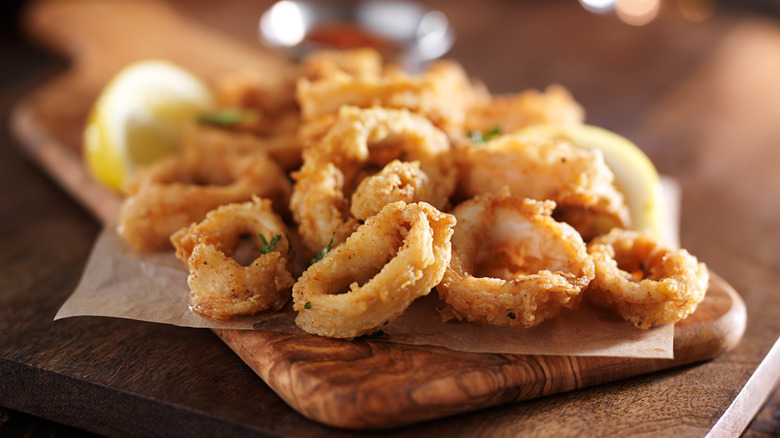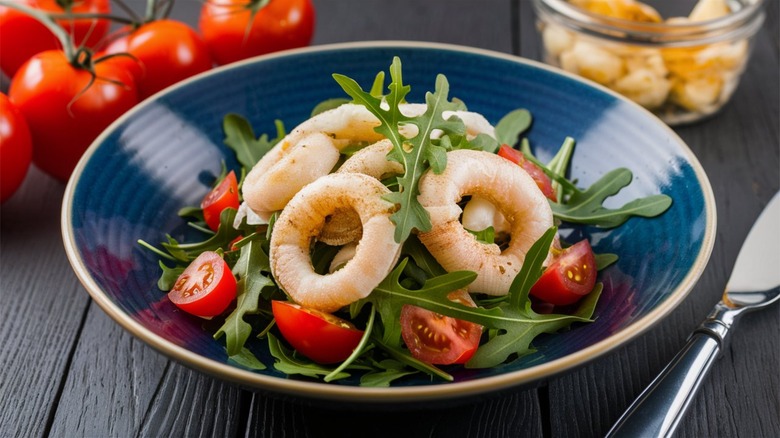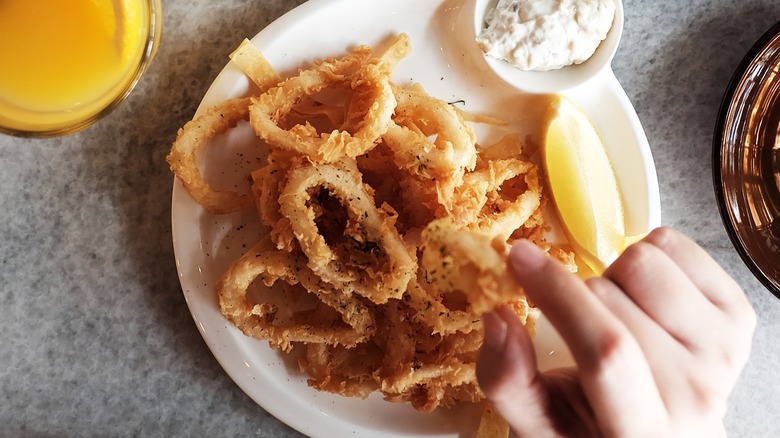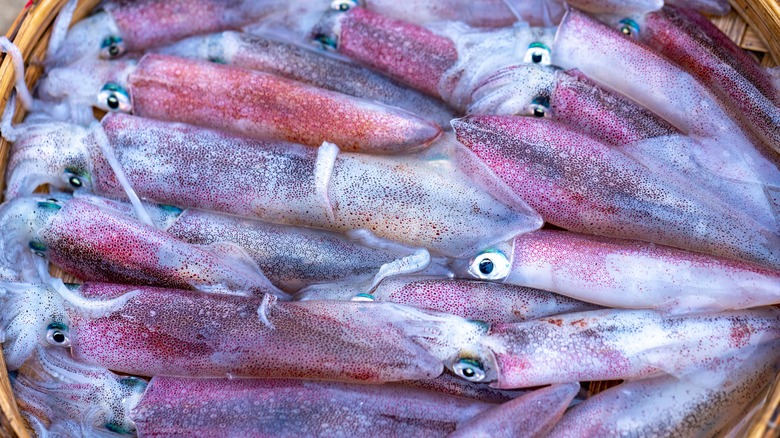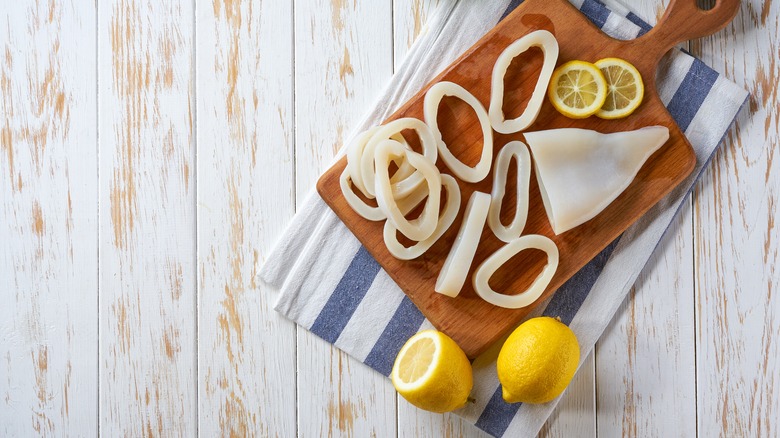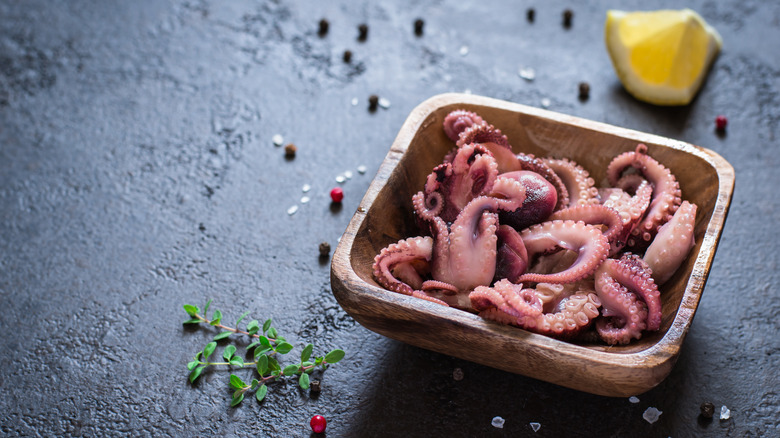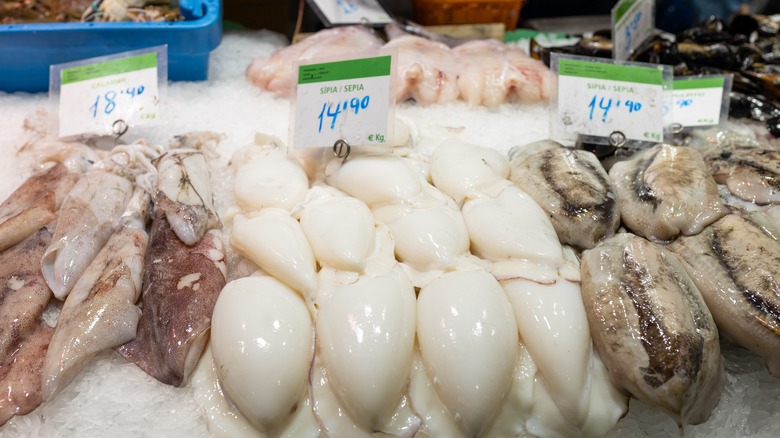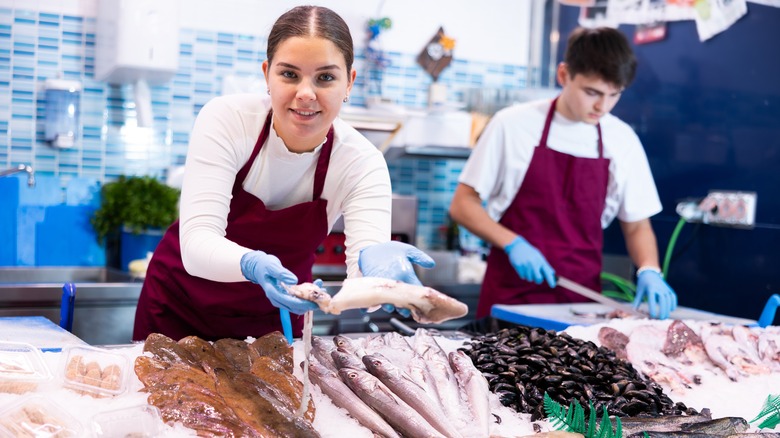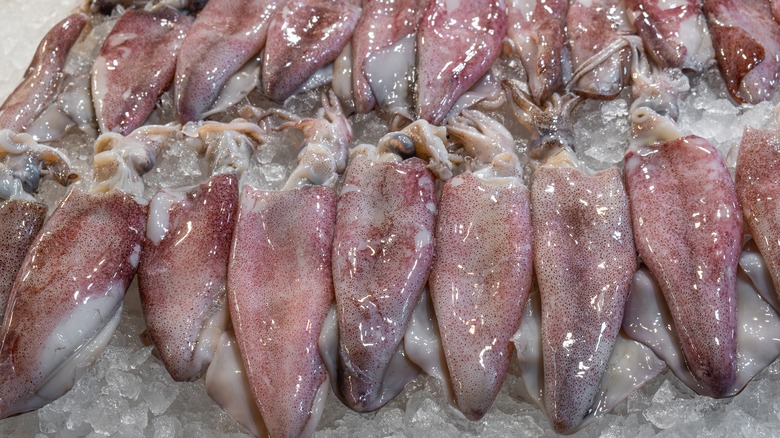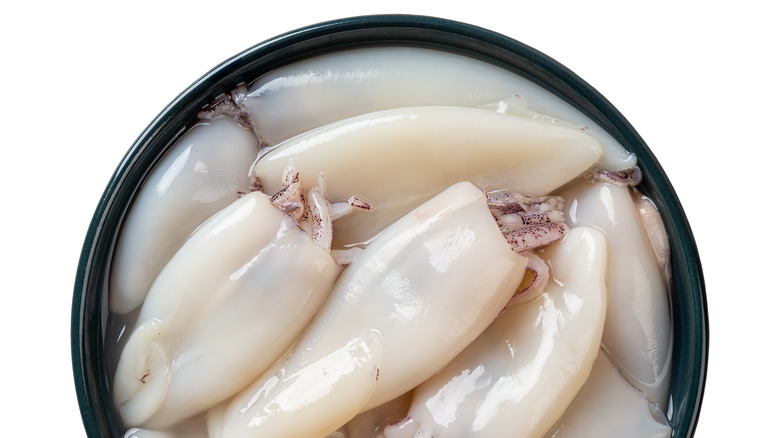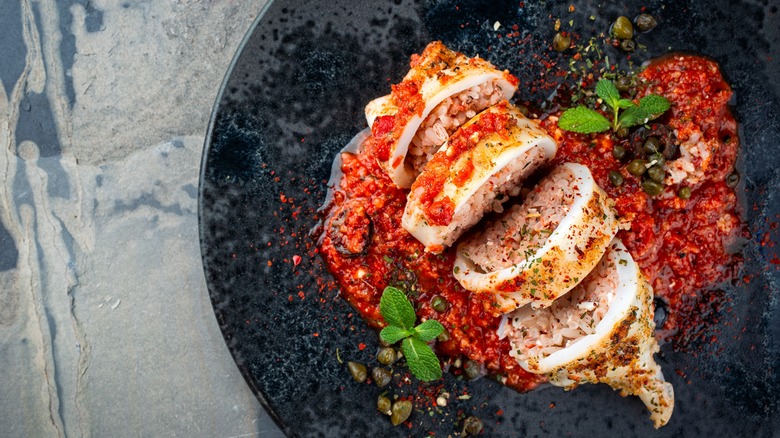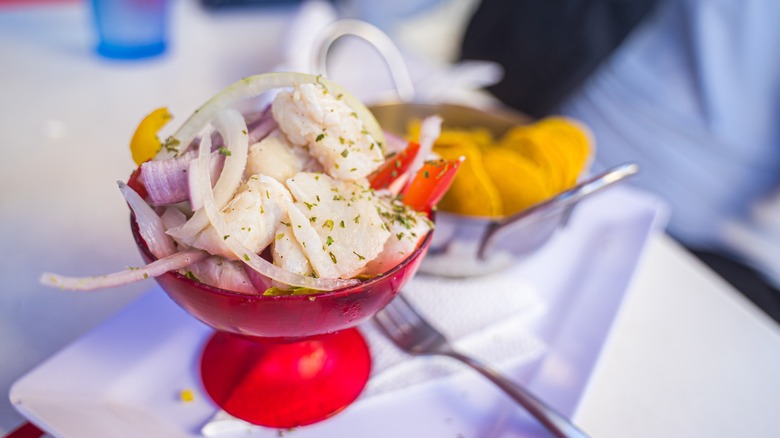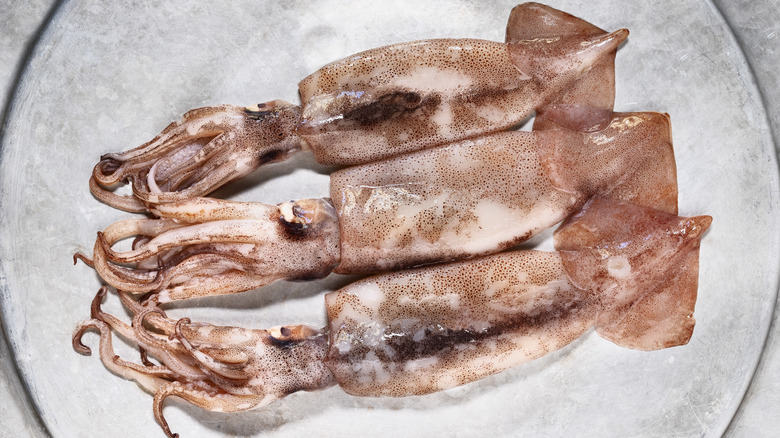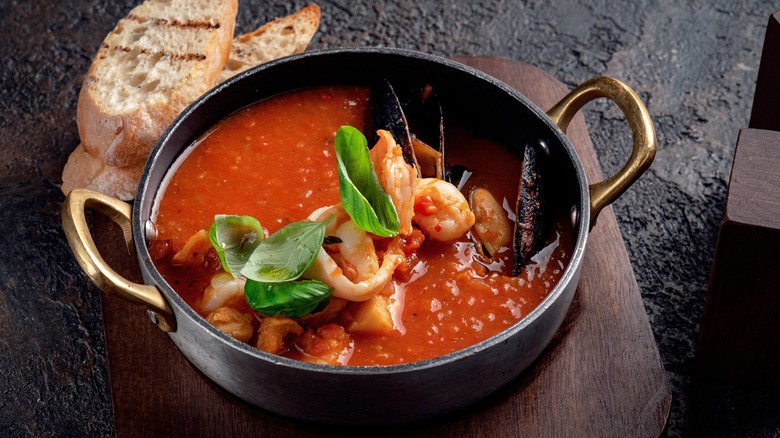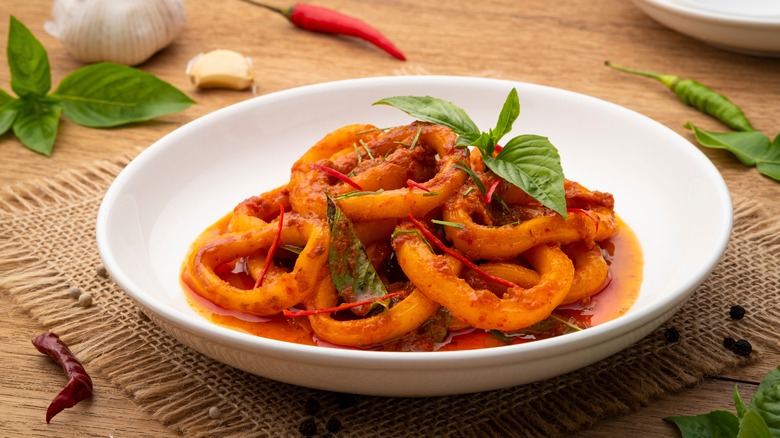What Is Calamari And What Part Of The Squid Is It?
If you've ever walked into a seafood restaurant and picked up a menu then you are no doubt familiar with calamari. This ubiquitous dish is found across America at sushi restaurants, Italian ristorantes, and divey fish-and-chips bars. Chewy, mildly briny, and usually fried or soaked in sauce, calamari is a staple food with a surprising history.
That said, while most foodies have at least tasted calamari, many people are out to sea (pun intended) when it comes to cooking it at home. Confusing matters more is the question of what calamari even refers to. The animal it comes from? The dish itself? Both? Add in the fact that most folks don't know where to find it at the grocery store or anywhere else, and you've got a triple threat. Et voilà, you're having chicken tonight.
The good news is, there are countless easy ways to prepare calamari at home. All you need is a start-to-finish guide to ensure you have the proper information. You'll quickly discover that it's a delicious and versatile food, easy to find, store, and prepare. From stews to curries, fried rings to fresh ceviche, calamari is here to impress your guests and please your palate. Don't wait any longer to learn more about it.
What is calamari?
While many people know that the two are related somehow, most aren't sure what the differences between calamari and squid are. The simplest answer to this question is that calamari is squid; the two words are both names for the same thing. Linguistically, "calamari" is Italian for "squids" (the singular of which is the somewhat adorable "calamaro"). However, some say that calamari is the culinary term for squid, whereas 'squid' refers to the animal. Kind of like how "pork" is understood to be a piece of meat and not a pig.
Although the most common preparation of calamari is battered or breaded and then deep-fat fried, it can also be sautéed or grilled. Most often, however, when you see it at a restaurant, it's going to fall under the appetizers section or perhaps feature on a captain's platter. So, you may be wondering, if squid and calamari are the same thing, why the two different names?
A brief history of calamari
Mediterranean people have been eating squid, either whole and stuffed or cut up, for generations, and those in Asian countries historically ate them sun-dried. It's also reasonable to assume someone at least tried them all the way back in the Pleistocene days since Neanderthals also ate sharks and dolphins.
However, squid wasn't a very popular food in America for most of the country's history. Before the '90s, when fishermen pulled them up in nets on accident, they usually threw them back. But when other seafood stocks began to decline, clever businesspeople decided to try and sell the U.S. crowd on the merits of this underappreciated seafood. Since "squid" sounds, let's face it, kind of gross, it was rebranded as "calamari" after its Romance language roots, then turned into a fancy appetizer. People bought it, both literally and figuratively, and the rest is history.
What part of the squid does calamari come from?
Calamari actually comes from several main parts of the squid. The first are the tentacles, which are cut off at the point where they meet the body. Squid also have two arms, which they use to grab prey and feed. These are also edible.
The third edible part of the squid is the mantle. This is the loose outer covering of the animal that contains the reproductive system, digestive tract, gills, ink sac, and the other necessities of being a squid. After cleaning it out, chefs commonly cut across the empty mantle to create rings, although it may also be cut into strips, left whole, or prepared in other ways.
So, here's a quick primer on identifying squid parts. If it has suction cups, it's a tentacle. Frequently, all eight are attached, though you may sometimes see individual tentacles on your plate. If it is a thick, smooth, noodly-looking thing cut into chunks, that's an arm. If it is a ring, that's the mantle.
The taste and texture of calamari
In general, squid is firm and slightly sweet. It can also be subtly nutty in flavor, but not in all cases. Others describe it as juicy, since it is tender and releases its liquid when cooked, or oceanic. When overcooked, squid tends to become rubbery. This is particularly problematic for home cooks since squid only takes seconds to cook through. If you do overcook it, however, you can return it to a tender state by continuing to cook it past the 30-minute mark.
While texture is usually a timing issue, the taste of the calamari depends on how the dish is prepared, because it easily absorbs the flavors of other ingredients and seasonings. When made into sushi or ceviche, the squid takes on overtones of citrus, wine, or vinegar. When breaded and fried, it becomes a classic salty appetizer. If grilled with veggies, it can absorb a classically Mediterranean flavor palate.
Bold squid ink, another popular upscale ingredient, has its own flavor: smooth, salty, and briny. Some home chefs collect the black liquid when cleaning squid at home, while others choose to buy it at the store. It can be used to make pasta sauce, flavor bread or rice, or be turned into a broth for serving with the squid that produced it.
How is calamari caught?
Squid may be caught with nets aboard commercial fishing boats dedicated to serving large culinary audiences, or using poles and lures or jigs by individual fishermen. (The latter approach is not guaranteed, however, and many a calamari lover has returned home disappointed. Squid are just plain sneaky.)
Commercial fishing operations often catch squid on the open ocean, along with fish and other species. However, anglers don't necessarily need a boat and can often use public piers, as squid are attracted to light. The easiest way to catch them is to go fishing after dark, during their common feeding time.
The good news is, squid have some seriously sustainable qualities. They are a low-carbon footprint food, and they may reproduce even more quickly in response to increasingly hot oceans. Acidification also doesn't seem to impact squid populations. However, calamari's skyrocketing popularity has encouraged unsustainable practices, especially in other countries, so you should always verify the source of your food before purchasing it.
Octopus may be mistakenly identified as calamari
Octopus is commonly mistakenly referred to as calamari. Squid and octopuses have many similarities, but also many differences. They have similar living environments, habits, and body parts. Both are indeed edible and common on menus around the world, and they are both popular in European and Asian cuisines especially.
The animals have two different body shapes. Squid are triangular or bullet-shaped, while octopuses have rounded heads. They are both (along with their close also edible cousin, the cuttlefish) equipped with ink that they use to defend themselves but their lifestyle habits differ. Squid may swim in schools, while octopuses are always solitary.
Octopuses and squid also differ in terms of taste. An octopus will have more of its own natural flavor, which some liken to pork or chicken. Because it will take on flavors that may mask its own, an octopus is often better cooked raw, according to some chefs. Squid, while smooth and delightfully chewy, is most often enjoyed in the company of other ingredients.
Calamari varieties and size ranges
While squid can grow up to 45 feet or more, you're not likely to want to eat those varieties. They will taste like complete garbage due to their high concentrations of ammonium chloride, so if you were even thinking of hauling one onto your dinner table Ahab-style, you can give that idea up pronto.
More than 300 squid species exist, but diners restrict themselves to only a few. In North America, the three main squid species eaten are the California market squid (Doryteuthis (Loligo) opalescens), the longfin inshore squid (Doryteuthis (Amerigo) pealeii), and the shortfin squid (ex illecebrosus). These can range in size from seven inches to 1.5 feet, depending on age and species.
Of these three species, only two are certified sustainable: the longfin inshore squid and the shortfin squid. If you want to do your best by the planet, look for the Marine Stewardship Council (MSC) certifications on the squid's packaging, or ask your fishmonger about the provenance of your seafood.
Where to buy calamari
You can find calamari in all sorts of places. The best source is right from the docks, where fishermen bring the catch in for the day. Some may sell it right off the boat, while others bring their haul to fish shops, where you can buy it fresh and take it home on ice. Note that buying from hobby anglers is illegal in some places, so check the rules for your state, province, or country.
If you don't have a seaside source, which most home cooks don't, a good fishmonger is the ideal runner-up. They will be able to tell you where the squid came from, what kind it is, how old it is, and whether or not it is sustainable.
Squid is also available frozen at the store, through specialty stores, or through online retailers. Avoid roadside stands unless you feel absolutely confident about the provenance of that seafood, in terms of both safety and legality.
How to choose the best squid
Choosing the freshest squid will result in the freshest taste, without the wharf-like aroma that can make seafood off-putting. Look for bright skin with red pigmentation and a white background. The flesh should be white as well. If the background color has darkened to yellow and the skin looks reddish, don't choose that, because it means the squid is older.
Note that the squid won't always have skin, though some chefs recommend it for the best dining experience. However, if you buy calamari already cleaned, its preparer may remove the skin along with the organs, beak, pen, and other unwanted structures.
Either way, when choosing squid, look for moisture and shine, firmness, and a mild briny smell. The odor should be clean, not fishy. If it smells like the docks or like ammonia, it's no longer good and you should shop elsewhere. You can avoid this by buying frozen, because squid is flash-frozen right after being caught, at maximum freshness.
How to prepare calamari for cooking
Learning to prepare squid is a bit of a task. First, if your squid is frozen, you should thaw it under refrigeration, which is a better way to defrost meat than in water or on the countertop. Note that even if you buy it "fresh" from the supermarket, this often means it was previously frozen and then thawed. The good news is, as long as you or the store makes sure to thaw it all the way, it will return to its original state of flavor and texture.
If you are cleaning squid yourself, you should approach the job carefully, especially if it's your first time, or that ink will make you sorry! To clean squid with less mess, hold the head (at the bottom of the mantle) and tail (at the top) in your two hands, then twist them apart. The organs should come out along with the head. If you wish, you can carefully remove the ink sack and drain it into a bowl with a bit of water. Be careful: it stains. Next, remove the beak from the top of the tentacles and the cartilage from the tail. If you're skinning your squid, do that last.
You will then need to cut your squid the way your recipe dictates, assuming it isn't already sliced up for you. It is normal to have far less mass from tentacles than from body, since the latter is much larger than the former.
How to cook calamari
It's impossible to answer the question of how to cook calamari succinctly since it can be found in culinary traditions ranging from New Zealand to Australia, China to Korea, the U.S. to South Africa, and beyond. There are so many different ways to prepare it that you're better off doing a web search for a recipe, whether classic or creative, that meets your dietary needs and ingredient list.
One of the best traits of calamari is that it absorbs flavor easily, so it is a nice base for dishes that carry other flavors. This is true for grilling when you want a smoky effect, or for sautéing with herbs and spices. Asian flavors that pair with squid include fish sauce, aromatics such as carrots and onions, black bean sauce, and more. Cooking in hot frying oil the classic way is also delicious, and you'll mostly get that umami flavor of crispy breading.
Other methods of preparation include sushi, ceviche, salad, stew, and a variety of clever appetizers. The tube shape of the squid suits it well for stuffing and then cooking. You should cook calamari either quickly at high heat or slowly at low heat. Cooking at temperatures in between will leave it rubbery and unpleasant. You can also use squid as a substitute for octopus in recipes.
Can you eat calamari raw?
You can eat calamari raw, and it is generally safe so long as you get it from a reputable sushi-grade provider. However, you should avoid it if you're pregnant, as is recommended with all raw or unpasteurized animal products. If you have any intestinal issues, you should also give it a miss. That said, raw calamari is often used as a sushi topping, though it is sometimes lightly cured first. In Korea, though, folks often consume it raw on its own.
If you're worried about safety, you can "cook" the fish without using heat by making it into ceviche or kilawin na pusit, a Filipino dish. This uses vinegar to kill bacteria and make it safe for consumption. Because vinegar is light and bright, you preserve the soft, sweet flavor of the squid while avoiding the possibility of contamination. It only takes about 15 minutes to do this.
Ceviche recipes sometimes use citrus juice as the bacteria-killing acid instead. For a Mexican spin, you can use lemon, lime, orange, or grapefruit juices along with ingredients such as cilantro, onion, and chiles, then let it sit for about an hour in the fridge. As with any recipe, just Google what you're looking for and follow it exactly ... especially when bacteria is a potential risk.
How to store calamari
Ideally, you should cook calamari the day you bring it home, but it will last up to three days in the fridge. Note that this is the maximum and, depending on the state of your squid when you bought it, is not guaranteed. It could spoil faster, so be as quick as you can in cooking and serving it.
If you have to store it, make sure to put it in an air-tight container, otherwise it can absorb smells from surrounding foods. The best options are reusable containers (ideal) or plates covered with plastic wrap (less sustainable). Keep it as cold as possible, storing it on a bed of ice, if you can.
In some cases, you may not be able to eat squid in the recommended three days. If that's the case, wait no longer than two days before freezing it. Clean and prep your squid, then put it in a freezer bag or other airtight freezer-appropriate container. Squid will keep between three and six months stored this way, but do discard it if you see freezer burn.
Health benefits of squid
Squid is exceptionally good for you like a lot of seafood is. Not only is it a filling, protein-rich food, but it also has all kinds of abilities to help you fight disease and maladies. For one thing, squid and its ink may fight cancer, according to a study in the Journal of Nutritional Science and Vitaminology.
A separate study published in Nutrients magazine notes that taurine (a component naturally found in animal tissue) from squid can also do all kinds of things for your heart health and cardiovascular system. This includes regulating your metabolism and blood pressure, improving vascular function, and increasing the overall fitness of your heart.
When prepared correctly and cooked, squid is a great food for pregnant women, who need lots of protein and iron. High levels of antioxidants can help fight free radicals, while dopamine from squid can put you in a better mood. It also helps with migraines, blood sugar, anemia, bone and teeth health, immunity, inflammation, child development, and more.
Calamari's nutritional information
Squid contains 18 grams of protein per 4-ounce serving. It also has tons of vitamins and minerals, from B12 and potassium to choline and Omega-3 fatty acids. It is relatively low in calories, though that can certainly change depending on how it is prepared. Hint: breading and deep-fat frying are not the way to go if you're trying to eat clean. While one cup of squid is about 150 calories, the same cup becomes about 350 calories if the calamari is fried.
Keep in mind that the nutritional information of calamari will be different in other dishes as well. You will likely get some nutrients from the surrounding ingredients, which certainly depends on the dish. But at the same time, cooking can reduce the amount of other nutrients, such as some B vitamins. Best not to worry about it overall, and to simply enjoy the number of dishes that involve (mostly) empty calories such as oil and breading in moderation.
